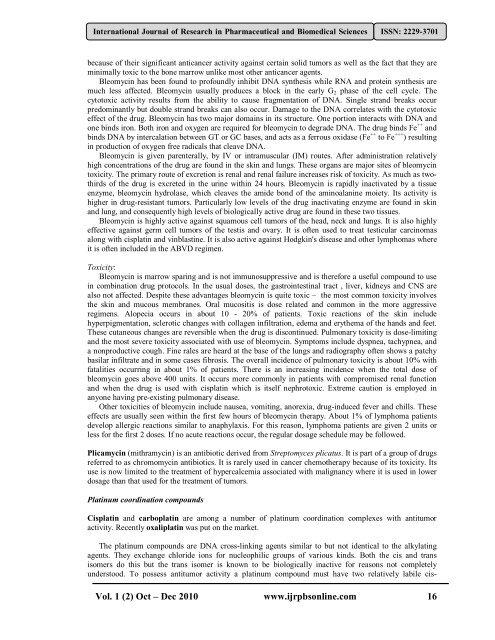Monitoring of Suspected Adverse Drug Reactions in Oncology Unit ...
Monitoring of Suspected Adverse Drug Reactions in Oncology Unit ...
Monitoring of Suspected Adverse Drug Reactions in Oncology Unit ...
Create successful ePaper yourself
Turn your PDF publications into a flip-book with our unique Google optimized e-Paper software.
International Journal <strong>of</strong> Research <strong>in</strong> Pharmaceutical and Biomedical Sciences ISSN: 2229-3701<br />
because <strong>of</strong> their significant anticancer activity aga<strong>in</strong>st certa<strong>in</strong> solid tumors as well as the fact that they are<br />
m<strong>in</strong>imally toxic to the bone marrow unlike most other anticancer agents.<br />
Bleomyc<strong>in</strong> has been found to pr<strong>of</strong>oundly <strong>in</strong>hibit DNA synthesis while RNA and prote<strong>in</strong> synthesis are<br />
much less affected. Bleomyc<strong>in</strong> usually produces a block <strong>in</strong> the early G 2 phase <strong>of</strong> the cell cycle. The<br />
cytotoxic activity results from the ability to cause fragmentation <strong>of</strong> DNA. S<strong>in</strong>gle strand breaks occur<br />
predom<strong>in</strong>antly but double strand breaks can also occur. Damage to the DNA correlates with the cytotoxic<br />
effect <strong>of</strong> the drug. Bleomyc<strong>in</strong> has two major doma<strong>in</strong>s <strong>in</strong> its structure. One portion <strong>in</strong>teracts with DNA and<br />
one b<strong>in</strong>ds iron. Both iron and oxygen are required for bleomyc<strong>in</strong> to degrade DNA. The drug b<strong>in</strong>ds Fe ++ and<br />
b<strong>in</strong>ds DNA by <strong>in</strong>tercalation between GT or GC bases, and acts as a ferrous oxidase (Fe ++ to Fe +++ ) result<strong>in</strong>g<br />
<strong>in</strong> production <strong>of</strong> oxygen free radicals that cleave DNA.<br />
Bleomyc<strong>in</strong> is given parenterally, by IV or <strong>in</strong>tramuscular (IM) routes. After adm<strong>in</strong>istration relatively<br />
high concentrations <strong>of</strong> the drug are found <strong>in</strong> the sk<strong>in</strong> and lungs. These organs are major sites <strong>of</strong> bleomyc<strong>in</strong><br />
toxicity. The primary route <strong>of</strong> excretion is renal and renal failure <strong>in</strong>creases risk <strong>of</strong> toxicity. As much as twothirds<br />
<strong>of</strong> the drug is excreted <strong>in</strong> the ur<strong>in</strong>e with<strong>in</strong> 24 hours. Bleomyc<strong>in</strong> is rapidly <strong>in</strong>activated by a tissue<br />
enzyme, bleomyc<strong>in</strong> hydrolase, which cleaves the amide bond <strong>of</strong> the am<strong>in</strong>oalan<strong>in</strong>e moiety. Its activity is<br />
higher <strong>in</strong> drug-resistant tumors. Particularly low levels <strong>of</strong> the drug <strong>in</strong>activat<strong>in</strong>g enzyme are found <strong>in</strong> sk<strong>in</strong><br />
and lung, and consequently high levels <strong>of</strong> biologically active drug are found <strong>in</strong> these two tissues.<br />
Bleomyc<strong>in</strong> is highly active aga<strong>in</strong>st squamous cell tumors <strong>of</strong> the head, neck and lungs. It is also highly<br />
effective aga<strong>in</strong>st germ cell tumors <strong>of</strong> the testis and ovary. It is <strong>of</strong>ten used to treat testicular carc<strong>in</strong>omas<br />
along with cisplat<strong>in</strong> and v<strong>in</strong>blast<strong>in</strong>e. It is also active aga<strong>in</strong>st Hodgk<strong>in</strong>'s disease and other lymphomas where<br />
it is <strong>of</strong>ten <strong>in</strong>cluded <strong>in</strong> the ABVD regimen.<br />
Toxicity:<br />
Bleomyc<strong>in</strong> is marrow spar<strong>in</strong>g and is not immunosuppressive and is therefore a useful compound to use<br />
<strong>in</strong> comb<strong>in</strong>ation drug protocols. In the usual doses, the gastro<strong>in</strong>test<strong>in</strong>al tract , liver, kidneys and CNS are<br />
also not affected. Despite these advantages bleomyc<strong>in</strong> is quite toxic – the most common toxicity <strong>in</strong>volves<br />
the sk<strong>in</strong> and mucous membranes. Oral mucositis is dose related and common <strong>in</strong> the more aggressive<br />
regimens. Alopecia occurs <strong>in</strong> about 10 - 20% <strong>of</strong> patients. Toxic reactions <strong>of</strong> the sk<strong>in</strong> <strong>in</strong>clude<br />
hyperpigmentation, sclerotic changes with collagen <strong>in</strong>filtration, edema and erythema <strong>of</strong> the hands and feet.<br />
These cutaneous changes are reversible when the drug is discont<strong>in</strong>ued. Pulmonary toxicity is dose-limit<strong>in</strong>g<br />
and the most severe toxicity associated with use <strong>of</strong> bleomyc<strong>in</strong>. Symptoms <strong>in</strong>clude dyspnea, tachypnea, and<br />
a nonproductive cough. F<strong>in</strong>e rales are heard at the base <strong>of</strong> the lungs and radiography <strong>of</strong>ten shows a patchy<br />
basilar <strong>in</strong>filtrate and <strong>in</strong> some cases fibrosis. The overall <strong>in</strong>cidence <strong>of</strong> pulmonary toxicity is about 10% with<br />
fatalities occurr<strong>in</strong>g <strong>in</strong> about 1% <strong>of</strong> patients. There is an <strong>in</strong>creas<strong>in</strong>g <strong>in</strong>cidence when the total dose <strong>of</strong><br />
bleomyc<strong>in</strong> goes above 400 units. It occurs more commonly <strong>in</strong> patients with compromised renal function<br />
and when the drug is used with cisplat<strong>in</strong> which is itself nephrotoxic. Extreme caution is employed <strong>in</strong><br />
anyone hav<strong>in</strong>g pre-exist<strong>in</strong>g pulmonary disease.<br />
Other toxicities <strong>of</strong> bleomyc<strong>in</strong> <strong>in</strong>clude nausea, vomit<strong>in</strong>g, anorexia, drug-<strong>in</strong>duced fever and chills. These<br />
effects are usually seen with<strong>in</strong> the first few hours <strong>of</strong> bleomyc<strong>in</strong> therapy. About 1% <strong>of</strong> lymphoma patients<br />
develop allergic reactions similar to anaphylaxis. For this reason, lymphoma patients are given 2 units or<br />
less for the first 2 doses. If no acute reactions occur, the regular dosage schedule may be followed.<br />
Plicamyc<strong>in</strong> (mithramyc<strong>in</strong>) is an antibiotic derived from Streptomyces plicatus. It is part <strong>of</strong> a group <strong>of</strong> drugs<br />
referred to as chromomyc<strong>in</strong> antibiotics. It is rarely used <strong>in</strong> cancer chemotherapy because <strong>of</strong> its toxicity. Its<br />
use is now limited to the treatment <strong>of</strong> hypercalcemia associated with malignancy where it is used <strong>in</strong> lower<br />
dosage than that used for the treatment <strong>of</strong> tumors.<br />
Plat<strong>in</strong>um coord<strong>in</strong>ation compounds<br />
Cisplat<strong>in</strong> and carboplat<strong>in</strong> are among a number <strong>of</strong> plat<strong>in</strong>um coord<strong>in</strong>ation complexes with antitumor<br />
activity. Recently oxaliplat<strong>in</strong> was put on the market.<br />
The plat<strong>in</strong>um compounds are DNA cross-l<strong>in</strong>k<strong>in</strong>g agents similar to but not identical to the alkylat<strong>in</strong>g<br />
agents. They exchange chloride ions for nucleophilic groups <strong>of</strong> various k<strong>in</strong>ds. Both the cis and trans<br />
isomers do this but the trans isomer is known to be biologically <strong>in</strong>active for reasons not completely<br />
understood. To possess antitumor activity a plat<strong>in</strong>um compound must have two relatively labile cis-<br />
Vol. 1 (2) Oct – Dec 2010 www.ijrpbsonl<strong>in</strong>e.com 16

















